Modulating Light Emission Performance of PCSEL via GaN HEMT Driving Circuit
Abstract
:1. Introduction
2. Modulating Light Emission Performance via Driving Circuit
2.1. Integrated System on a Matrix Board
2.2. Electro-Optical Responses of the Driving Circuit
2.3. Optical Behaviors of Relevant Light Emission
3. Reliability Test for the Integrated System
3.1. Self-Heating Effect of PCSEL in High-Frequency Operation
3.2. Relevant Side Mode Suppression Ratios under Different Conditions
4. Conclusions
Author Contributions
Funding
Institutional Review Board Statement
Informed Consent Statement
Data Availability Statement
Acknowledgments
Conflicts of Interest
References
- Brinkløv, S.; Fenton, M.B.; Ratcliffe, J.M. Echolocation in oilbirds and swiftlets. Front. Physiol. 2013, 4, 123. [Google Scholar] [CrossRef] [PubMed]
- Novacek, M.J. Evidence for echolocation in the oldest known bats. Nature 1985, 315, 140–141. [Google Scholar] [CrossRef]
- Au, W.W.; Benoit-Bird, K.J. Automatic gain control in the echolocation system of dolphins. Nature 2003, 423, 861–863. [Google Scholar] [CrossRef]
- Zhou, X.; Sun, F.; Xu, S.; Fan, G.; Zhu, K.; Liu, X.; Chen, Y.; Shi, C.; Yang, Y.; Huang, Z.; et al. Baiji genomes reveal low genetic variability and new insights into secondary aquatic adaptations. Nat. Commun. 2013, 4, 2708. [Google Scholar] [CrossRef] [PubMed]
- Bhandari, A.; Raskar, R. Signal processing for time-of-flight imaging sensors: An introduction to inverse problems in computational 3-D imaging. IEEE Signal Process. Mag. 2016, 33, 45–58. [Google Scholar] [CrossRef]
- Horaud, R.; Hansard, M.; Evangelidis, G.; Ménier, C. An overview of depth cameras and range scanners based on time-of-flight technologies. Mach. Vis. Appl. 2016, 27, 1005–1020. [Google Scholar] [CrossRef]
- 3D Imaging and Sensing-Technology and Market Trends 2021. Available online: https://www.i-micronews.com/products/3d-imaging-and-sensing-technology-and-market-trends-2021/ (accessed on 7 July 2022).
- Light Detection and Ranging (LiDAR) Market. Available online: https://www.fortunebusinessinsights.com/light-detection-and-ranging-lidar-market-101969 (accessed on 7 July 2022).
- O’Toole, M.; Lindell, D.B.; Wetzstein, G. Confocal non-line-of-sight imaging based on the light-cone transform. Nature 2018, 555, 338–341. [Google Scholar] [CrossRef]
- Kirmani, A.; Venkatraman, D.; Shin, D.; Colaço, A.; Wong, F.N.; Shapiro, J.H.; Goyal, V.K. First-photon imaging. Science 2014, 343, 58–61. [Google Scholar] [CrossRef]
- McCarthy, A.; Krichel, N.J.; Gemmell, N.R.; Ren, X.; Tanner, M.G.; Dorenbos, S.N.; Zwiller, V.; Hadfield, R.H.; Buller, G.S. Kilometer-range, high resolution depth imaging via 1560 nm wavelength single-photon detection. Opt. Express 2013, 21, 8904–8915. [Google Scholar] [CrossRef]
- Schwarz, B. Mapping the world in 3D. Nat. Photonics 2010, 4, 429–430. [Google Scholar] [CrossRef]
- van Tricht, K.; Lhermitte, S.; Lenaerts, J.T.; Gorodetskaya, I.V.; L’Ecuyer, T.S.; Noël, B.; van den Broeke, M.R.; Turner, D.D.; van Lipzig, N.P. Clouds enhance Greenland ice sheet meltwater runoff. Nat. Commun. 2016, 7, 10266. [Google Scholar] [CrossRef] [PubMed]
- Pedreros Bustos, F.; Bonaccini Calia, D.; Budker, D.; Centrone, M.; Hellemeier, J.; Hickson, P.; Holzlöhner, R.; Rochester, S. Remote sensing of geomagnetic fields and atomic collisions in the mesosphere. Nat. Commun. 2018, 9, 3981. [Google Scholar] [CrossRef] [PubMed]
- Sutfin, N.A.; Wohl, E. Elevational differences in hydrogeomorphic disturbance regime influence sediment residence times within mountain river corridors. Nat. Commun. 2019, 10, 2221. [Google Scholar] [CrossRef]
- McManamon, P. Review of ladar: A historic, yet emerging, sensor technology with rich phenomenology. Opt. Eng. 2012, 51, 060901. [Google Scholar] [CrossRef]
- Moosmann, F.; Stiller, C. Velodyne slam. In Proceedings of the IEEE Intelligent Vehicles Symposium (IV), Baden-Baden, Germany, 5–9 June 2011; pp. 393–398. [Google Scholar]
- Li, Q.; Chen, L.; Li, M.; Shaw, S.L.; Nüchter, A. A sensor-fusion drivable-region and lane-detection system for autonomous vehicle navigation in challenging road scenarios. IEEE Trans. Veh. Technol. 2013, 63, 540–555. [Google Scholar] [CrossRef]
- McCormack, J.; Prine, J.; Trowbridge, B.; Rodriguez, A.C.; Integlia, R. 2D LIDAR as a distributed interaction tool for virtual and augmented reality video games. In Proceedings of the IEEE Games Entertainment Media Conference (GEM), Toronto, ON, Canada, 1 October 2015; pp. 1–5. [Google Scholar]
- CENELEC. Safety of laser products-Part 1: Equipment classification, requirements and user’s guide. In Proceedings of the International Electrotechnical Commission (IEC), Geneva, Switzerland, 16 October 2007.
- McManamon, P.F. Lidar Technologies and Systems; SPIE: Bellingham, WA, USA, 2019. [Google Scholar]
- Hendow, S.T.; Shakir, S.A. Structuring materials with nanosecond laser pulses. Opt. Express 2010, 18, 10188–10199. [Google Scholar] [CrossRef]
- Ma, Y.S.; Lin, Z.Y.; Lin, Y.T.; Lee, C.Y.; Huang, T.P.; Chen, K.H.; Lin, Y.H.; Lin, S.R.; Tsai, T.Y. 29.6 A digital-type GaN driver with current-pulse-balancer technique achieving sub-nanosecond current pulse width for high-resolution and dynamic effective range LiDAR system. In Proceedings of the IEEE International Solid-State Circuits Conference (ISSCC), San Francisco, CA, USA, 17–21 February 2019; pp. 466–468. [Google Scholar]
- Nie, M.; Liu, Q.; Ji, E.; Cao, X.; Xing, F.; Gong, M. High peak power hybrid MOPA laser with tunable pulse repetition frequency and pulse duration. Appl. Opt. 2017, 56, 3457–3461. [Google Scholar] [CrossRef]
- Wu, C.C.; Liu, C.Y.; Wang, G.B.; Shieh, Y.T.; Chieng, W.H.; Chang, E.Y. A New GaN-Based Device, P-Cascode GaN HEMT, and Its Synchronous Buck Converter Circuit Realization. Energies 2021, 14, 3477. [Google Scholar] [CrossRef]
- Hamamatsu Photonics, Photonic Crystal Surface Emitting Laser Diodes (PCSEL). Available online: https://www.hamamatsu.com/jp/en.html (accessed on 29 July 2022).
- Dora, Y.; Chakraborty, A.; Mccarthy, L.; Keller, S.; DenBaars, S.P.; Mishra, U.K. High breakdown voltage achieved on AlGaN/GaN HEMTs with integrated slant field plates. IEEE Electron Device Lett. 2006, 27, 713–715. [Google Scholar] [CrossRef]
- Zeng, F.; An, J.X.; Zhou, G.; Li, W.; Wang, H.; Duan, T.; Jiang, L.; Yu, H. A comprehensive review of recent progress on GaN high electron mobility transistors: Devices, fabrication and reliability. Electronics 2018, 7, 377. [Google Scholar] [CrossRef] [Green Version]
- Russo, S.; Di Carlo, A. Influence of the source–gate distance on the AlGaN/GaN HEMT performance. IEEE Trans. Electron. Devices 2007, 54, 1071–1075. [Google Scholar] [CrossRef]
- Oka, T.; Ina, T.; Ueno, Y.; Nishii, J. 1.8 mΩ·cm2 vertical GaN-based trench metal–oxide–semiconductor field-effect transistors on a free-standing GaN substrate for 1.2-kV-class operation. Appl. Phys. Express 2015, 8, 054101. [Google Scholar] [CrossRef]
- Heikman, S.; Keller, S.; Green, D.S.; DenBaars, S.P.; Mishra, U.K. High conductivity modulation doped AlGaN/GaN multiple channel heterostructures. J. Appl. Phys. 2003, 94, 5321–5325. [Google Scholar] [CrossRef]
- Glaser, J. How GaN power transistors drive high-performance lidar: Generating ultrafast pulsed power with GaN FETs. IEEE Power Electron. Mag. 2017, 4, 25–35. [Google Scholar] [CrossRef]
- Park, M.; Baek, Y.; Dinare, M.; Lee, D.; Park, K.H.; Ahn, J.; Kim, D.; Medina, J.; Choi, W.J.; Kim, S.; et al. Hetero-integration enables fast switching time-of-flight sensors for light detection and ranging. Sci. Rep. 2020, 10, 2764. [Google Scholar] [CrossRef]
- Iga, K. Laboratory Notebook; 1977. [Google Scholar]
- Iga, K.; Koyama, F.; Kinoshita, S. Surface emitting semiconductor lasers. IEEE J. Quantum Electron. 1988, 24, 1845–1855. [Google Scholar] [CrossRef]
- Iga, K. Surface-emitting laser-its birth and generation of new optoelectronics field. IEEE J. Sel. Top. Quantum Electron. 2000, 6, 1201–1215. [Google Scholar] [CrossRef]
- Iga, K. Vertical-cavity surface-emitting laser: Its conception and evolution. Jpn. J. Appl. Phys. 2008, 47, 1. [Google Scholar] [CrossRef]
- Iga, K. Vertical-cavity surface-emitting laser (VCSEL). Proc. IEEE 2013, 101, 2229–2233. [Google Scholar] [CrossRef]
- Koyama, F.; Kinoshita, S.; Iga, K. Room temperature cw operation of GaAs vertical cavity surface emitting laser. IEICE Trans. Electron. 1988, 71, 1089–1090. [Google Scholar]
- Larsson, A. Advances in VCSELs for communication and sensing. IEEE J. Sel. Top. Quantum Electron. 2011, 17, 1552–1567. [Google Scholar] [CrossRef]
- Moser, P.; Lott, J.A.; Bimberg, D. Energy efficiency of directly modulated oxide-confined high bit rate 850-nm VCSELs for optical interconnects. IEEE J. Sel. Top. Quantum Electron. 2013, 19, 1702212. [Google Scholar] [CrossRef]
- Pruijmboom, A.; Apetz, R.; Conrads, R.; Deppe, C.; Derra, G.; Gronenborn, S.; Gu, X.; Kolb, J.S.; Miller, M.; Moench, H.; et al. VCSEL arrays expanding the range of high-power laser systems and applications. J. Laser Appl. 2016, 28, 032005. [Google Scholar] [CrossRef]
- Ebeling, K.J.; Michalzik, R.; Moench, H. Vertical-cavity surface-emitting laser technology applications with focus on sensors and three-dimensional imaging. Jpn. J. Appl. Phys. 2018, 57, 08PA02. [Google Scholar] [CrossRef]
- Liu, A.; Wolf, P.; Lott, J.A.; Bimberg, D. Vertical-cavity surface-emitting lasers for data communication and sensing. Photonics Res. 2019, 7, 121–136. [Google Scholar] [CrossRef]
- Ishizaki, K.; De Zoysa, M.; Noda, S. Progress in photonic-crystal surface-emitting lasers. Photonics 2019, 6, 96. [Google Scholar] [CrossRef]
- Kalapala, A.; Song, A.; Pan, M.; Gautam, C.; Overman, L.; Reilly, K.; Rotter, T.; Balakrishnan, G.; Gibson, R.; Bedford, R.; et al. Scaling challenges in high power photonic crystal surface-emitting lasers. IEEE J. Quantum Electron. 2022, 58, 1–9. [Google Scholar] [CrossRef]
- Wang, Z.; Tong, C.; Wang, L.; Lu, H.; Tian, S.; Wang, L. Photonic crystal surface emitting laser operating in pulse-periodic regime with ultralow divergence angle. Photonics 2021, 8, 323. [Google Scholar] [CrossRef]
- Taylor, R.J.; Childs, D.; Hogg, R. Vector photonics: The commercial journey of PCSELs and their pathway to high power. In Proceedings of the SPIE High-Power Diode Laser Technology XX, San Francisco, CA, USA, 22 January–28 February 2022; Volume PC1198304. [Google Scholar]
- de Zoysa, M.; Inoue, T.; Yoshida, M.; Ishizaki, K.; Kunishi, W.; Gelleta, J.; Noda, S. Light detection functionality of photonic-crystal lasers. IEEE J. Quantum Electron. 2021, 57, 6400208. [Google Scholar] [CrossRef]
- Noda, S. Progress of photonic crystal surface-emitting lasers: Paradigm shift for lidar sensing and laser processing. In Proceedings of the Laser Resonators, Microresonators, and Beam Control XXIII, Virtual, 6–12 March 2021; Volume 11672, p. 1167203. [Google Scholar]
- Noda, S. Photonic crystal surface-emitting lasers and their application to lidar. In Proceedings of the 2021 26th Microoptics Conference (MOC), Hamamatsu, Japan, 26–29 September 2021; pp. 1–2. [Google Scholar]
- Hong, Y.H.; Miao, W.C.; Hsu, W.C.; Hong, K.B.; Lin, C.L.; Lin, C.; Chen, S.C.; Kuo, H.C. Progress of Photonic-Crystal Surface-Emitting Lasers: A Paradigm Shift in LiDAR Application. Crystals 2022, 12, 800. [Google Scholar] [CrossRef]
- Glaser, J. High power nanosecond pulse laser driver using an GaN FET. In Proceedings of the International Exhibition and Conference for Power Electronics, Intelligent Motion, Renewable Energy and Energy Management, Nuremberg, Germany, 5–7 June 2018; pp. 1–8. [Google Scholar]
- Fornetti, F.; Morris, K.A.; Beach, M.A. Pulsed operation and performance of commercial GaN HEMTs. In Proceedings of the IEEE European Microwave Integrated Circuits Conference (EuMIC), Rome, Italy, 28–29 September 2009; pp. 226–229. [Google Scholar]
- Kuzmik, J.; Javorka, R.; Alam, A.; Marso, M.; Heuken, M.; Kordos, P. Determination of channel temperature in AlGaN/GaN HEMTs grown on sapphire and silicon substrates using DC characterization method. IEEE Trans. Electron. Devices 2002, 49, 1496–1498. [Google Scholar] [CrossRef]
- Wens, M.; Redoute, J.M.; Blanchaert, T.; Bleyaert, N.; Steyaert, M. An integrated 10A, 2.2 ns rise-time laser-diode driver for LIDAR applications. In Proceedings of the European Solid-State Circuits Conference (ESSCIRC), Athens, Greece, 14–18 September 2009; pp. 144–147. [Google Scholar]
- Weng, Y.C.; Wu, C.C.; Chang, E.Y.; Chieng, W.H. Minimum power input control for class-e amplifier using depletion-mode gallium nitride high electron mobility transistor. Energies 2021, 14, 2302. [Google Scholar] [CrossRef]
- De Zoysa, M.; Yoshida, M.; Song, B.; Ishizaki, K.; Inoue, T.; Katsuno, S.; Izumi, K.; Tanaka, Y.; Hatsuda, R.; Gelleta, J.; et al. Thermal management for CW operation of large-area double-lattice photonic-crystal lasers. JOSA B 2020, 37, 3882–3887. [Google Scholar] [CrossRef]
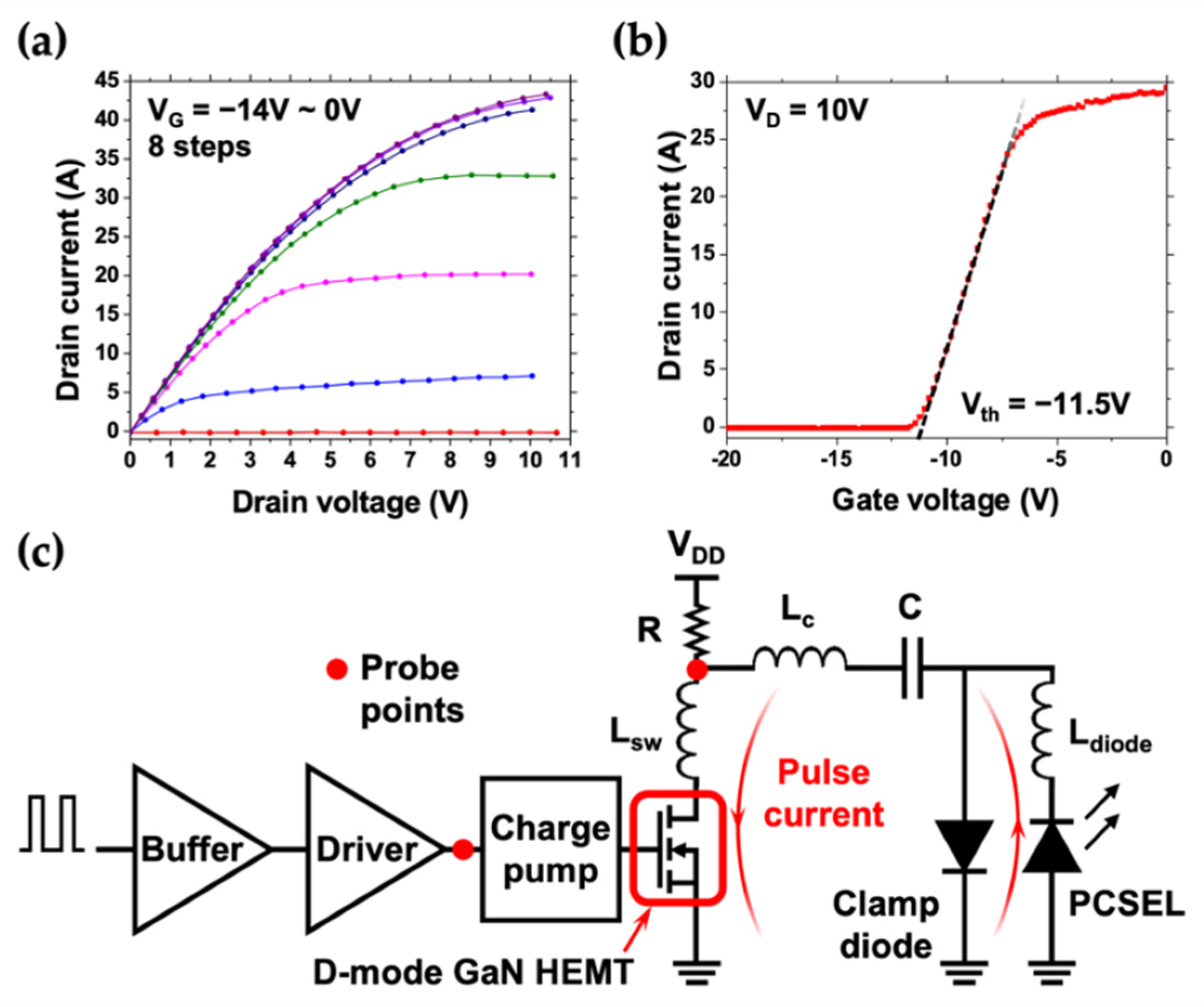
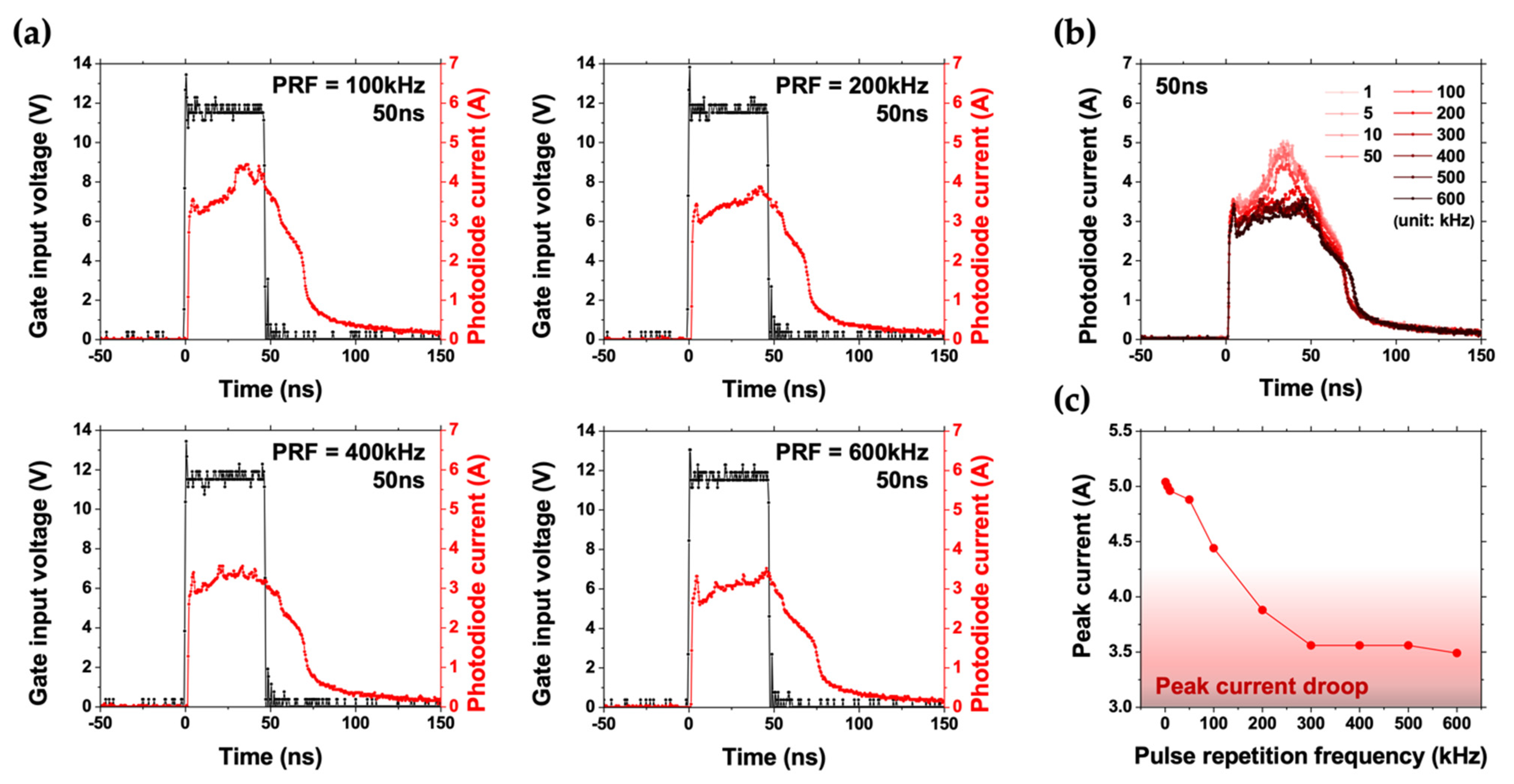
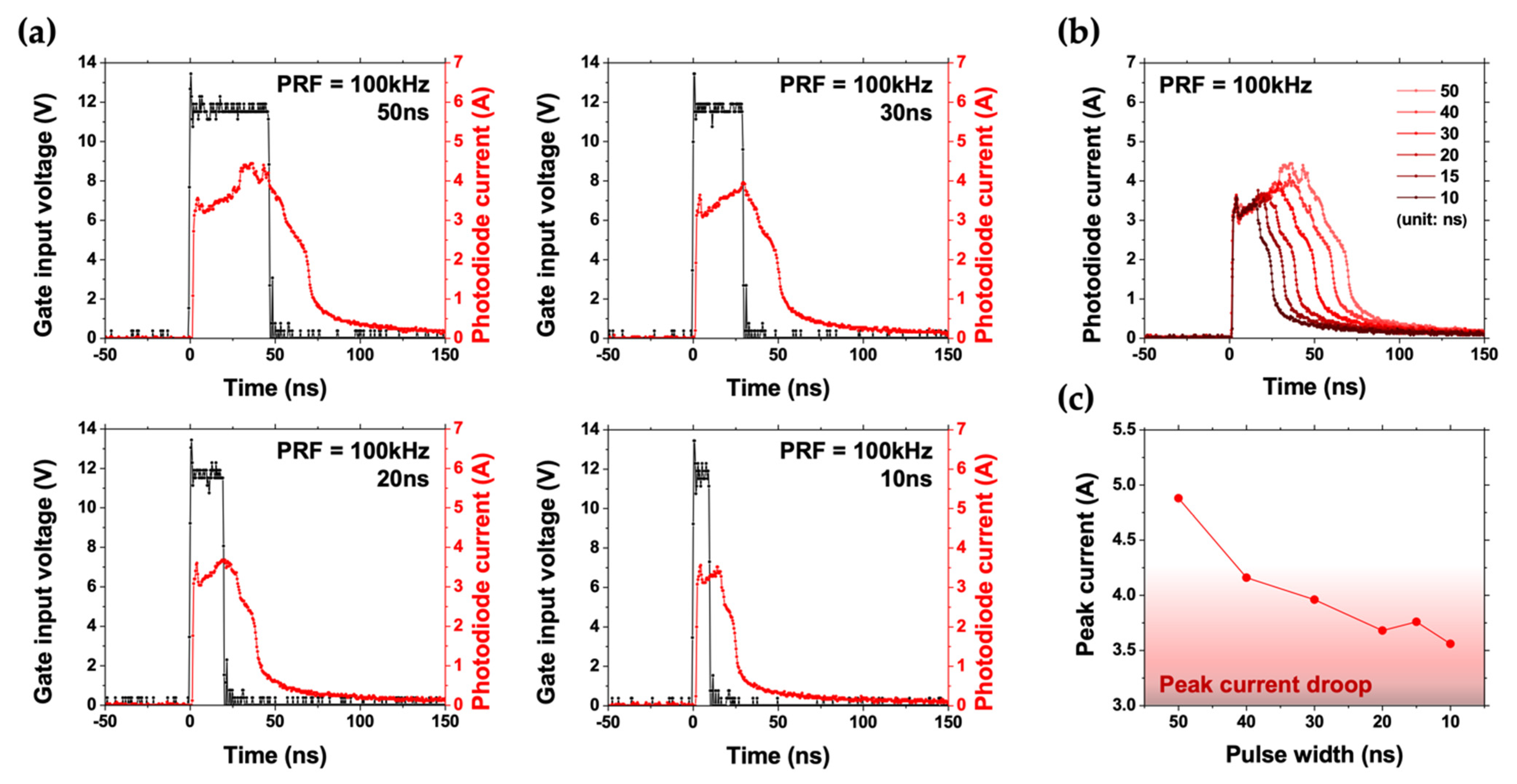
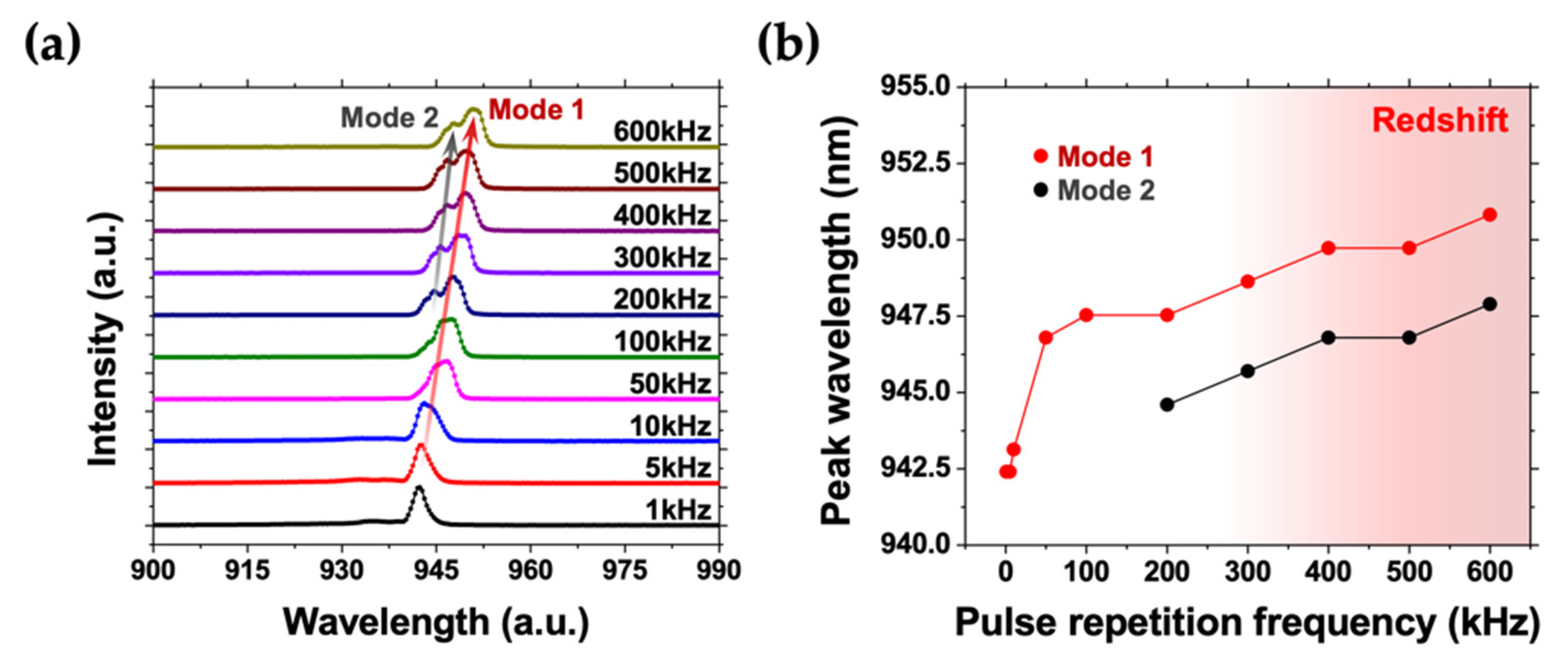
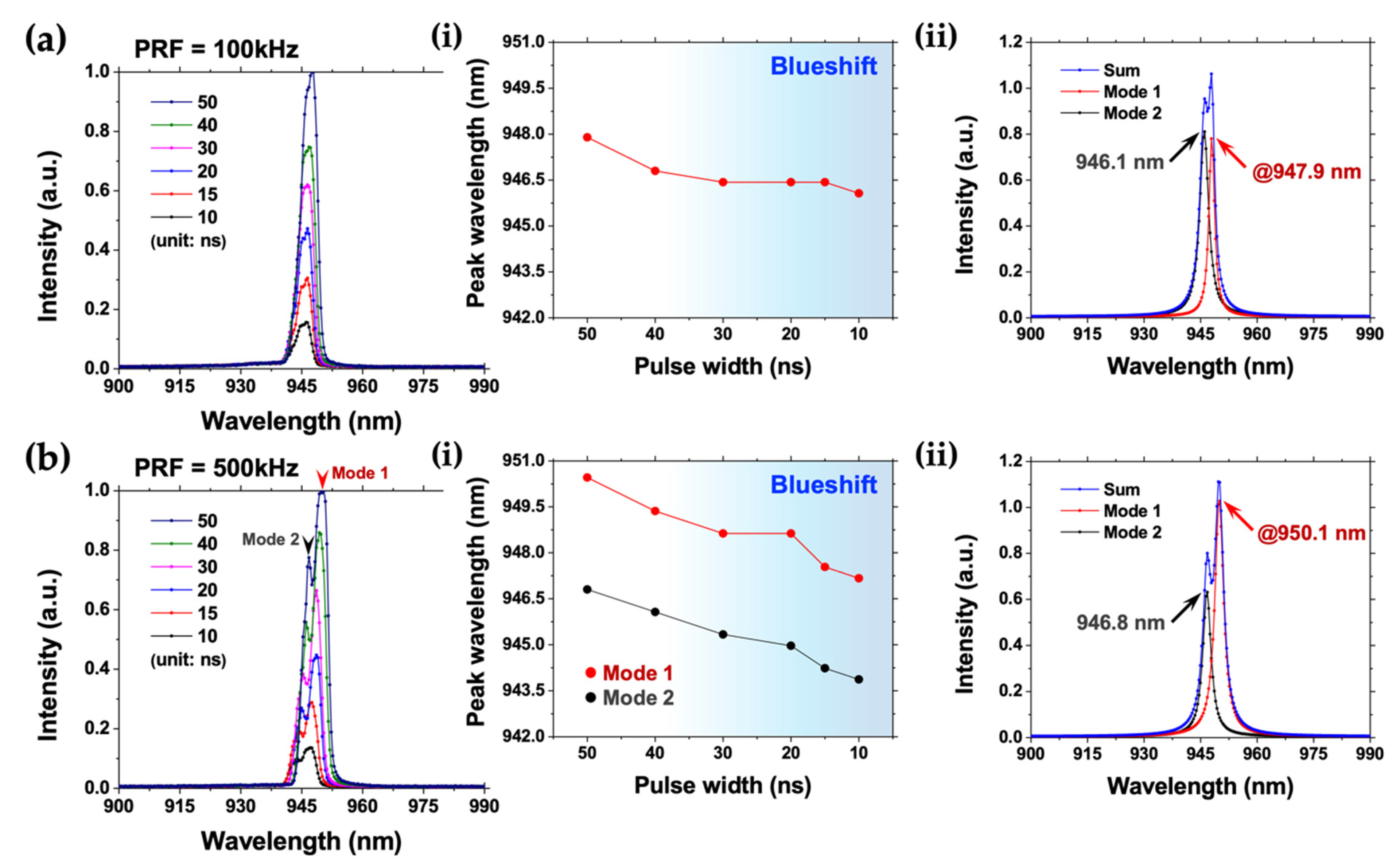

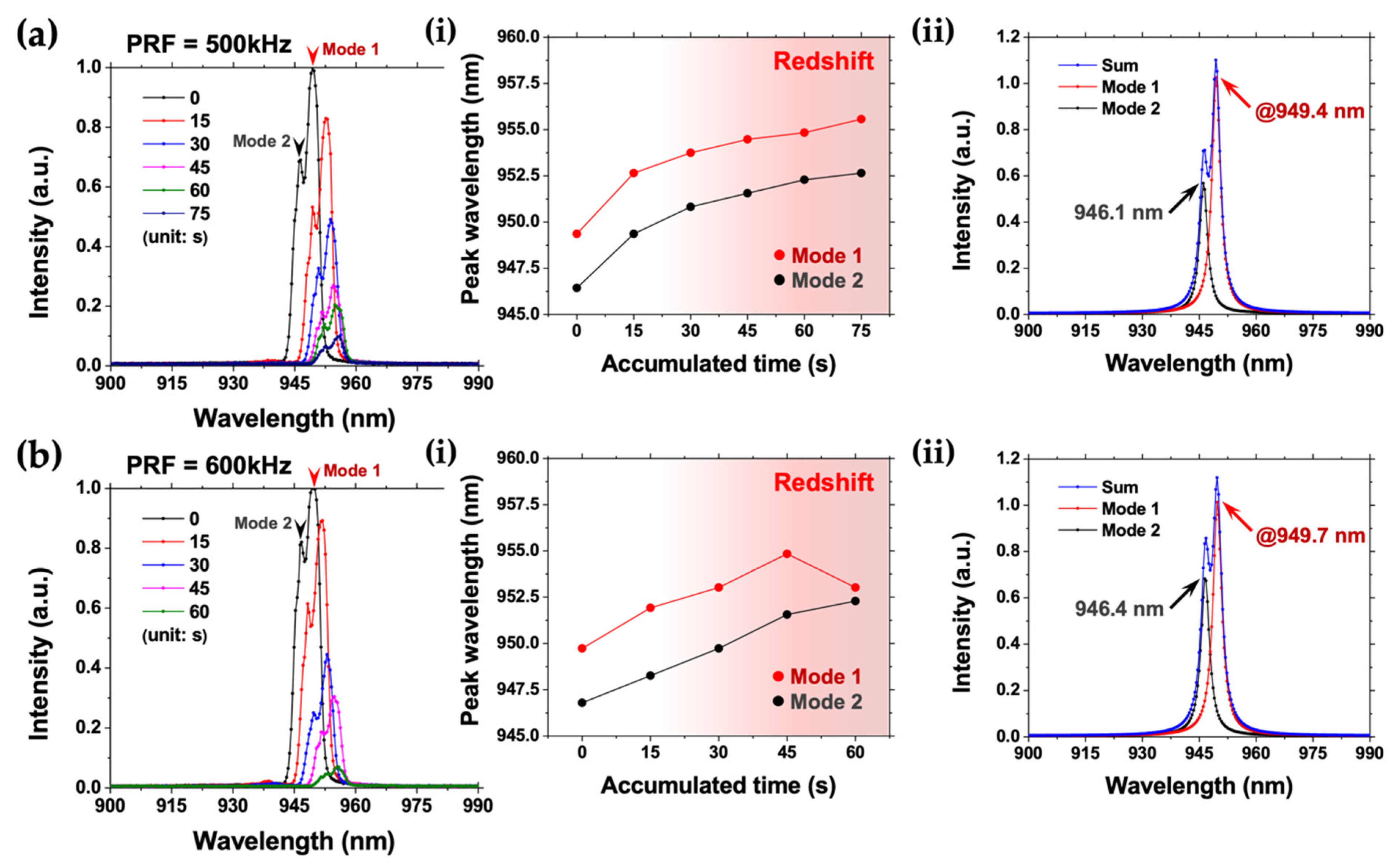
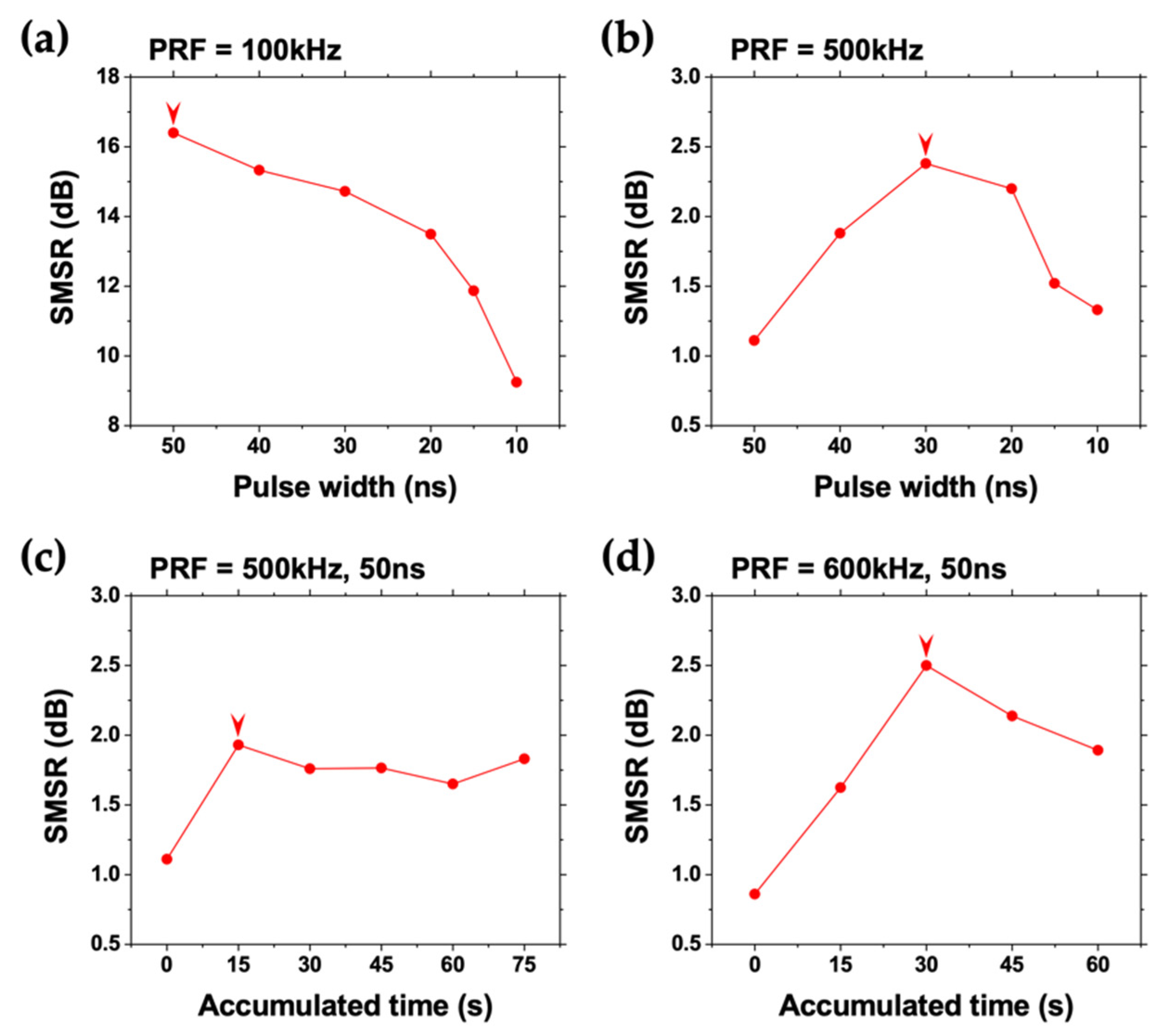
Publisher’s Note: MDPI stays neutral with regard to jurisdictional claims in published maps and institutional affiliations. |
© 2022 by the authors. Licensee MDPI, Basel, Switzerland. This article is an open access article distributed under the terms and conditions of the Creative Commons Attribution (CC BY) license (https://creativecommons.org/licenses/by/4.0/).
Share and Cite
Hong, Y.-H.; Liu, C.-Y.; Chen, J.-D.; Peng, C.-Y.; Tang, L.-C.; Lu, T.-C.; Lin, C.-H.; Chieng, W.-H.; Chang, E.Y.; Chen, S.-C.; et al. Modulating Light Emission Performance of PCSEL via GaN HEMT Driving Circuit. Crystals 2022, 12, 1242. https://doi.org/10.3390/cryst12091242
Hong Y-H, Liu C-Y, Chen J-D, Peng C-Y, Tang L-C, Lu T-C, Lin C-H, Chieng W-H, Chang EY, Chen S-C, et al. Modulating Light Emission Performance of PCSEL via GaN HEMT Driving Circuit. Crystals. 2022; 12(9):1242. https://doi.org/10.3390/cryst12091242
Chicago/Turabian StyleHong, Yu-Heng, Ching-Yao Liu, Jun-Da Chen, Chun-Yen Peng, Li-Chuan Tang, Tien-Chang Lu, Chun-Hsiung Lin, Wei-Hua Chieng, Edward Yi Chang, Shih-Chen Chen, and et al. 2022. "Modulating Light Emission Performance of PCSEL via GaN HEMT Driving Circuit" Crystals 12, no. 9: 1242. https://doi.org/10.3390/cryst12091242
APA StyleHong, Y.-H., Liu, C.-Y., Chen, J.-D., Peng, C.-Y., Tang, L.-C., Lu, T.-C., Lin, C.-H., Chieng, W.-H., Chang, E. Y., Chen, S.-C., & Kuo, H.-C. (2022). Modulating Light Emission Performance of PCSEL via GaN HEMT Driving Circuit. Crystals, 12(9), 1242. https://doi.org/10.3390/cryst12091242











